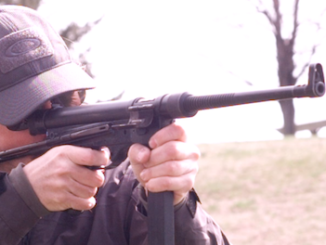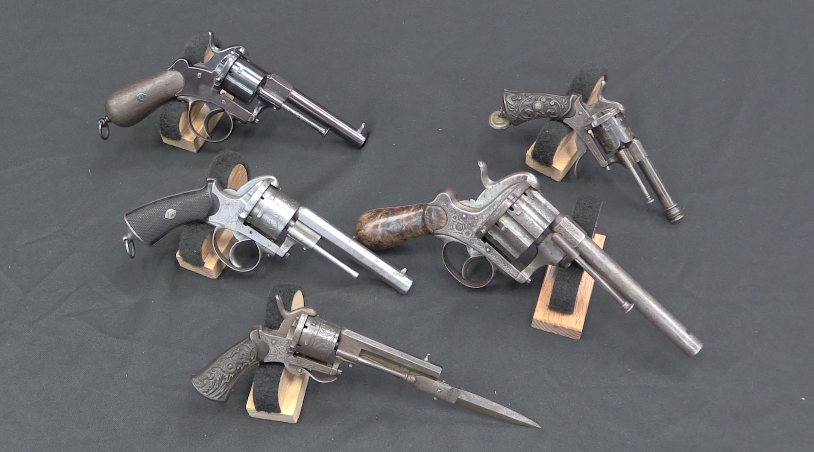Lot 1485 in the September 2020 RIA Premier auction.
The FN Model D (“demontage”, or detachable) was the last and best evolution of the Browning Automatic Rifle. FN acquired a license to make the BAR in 1920 from Colt, and made its first major sale to Poland in 1928. Using that income to finance its production tooling, FN would introduce its Model 30 version of the BAR (essentially a duplicate of the contemporary Colt model 1925). However, a team led by Dieudonné Saive continued to work on the design and in 1932 they introduced the improved Model D. This featured a mechanical rate reducing mechanism offering about 350 rpm on slow and about 600 rpm on fast. It had a new and improved magazine release, and most importantly a receiver redesigned to allow quick and easy field stripping and a quick-detach barrel. Production continued after World War Two, not ending until 1967. The final iteration of the Model D was the DA1, adapted to use the new 7.62mm NATO cartridge from standard FAL rifle magazines. The FN-D would be adopted by nationals all over the world, including Finland, Netherlands, Luxembourg, Colombia, Belgium, and Egypt.




What caliber were the Finish purchase ?
7.92 x 57 JS
These were a buy of necessity, ie the Finns did buy anything they could find during the Winter War.
“Finns did buy anything they could find during the Winter War.”
According to https://www.jaegerplatoon.net/LMG2.htm 700 examples of Fusil automatique Browning type D were bought in February of 1940, but not issued during said conflict: They were not yet issued during Winter War, but during Continuation War they were first issued to fortification troops and later mainly to coastal troops. The likelyreason for this was their calibre – unlike frontline infantry (armed mainly with weapons chambered 7.62 mm x 54R) these troops used also German MG-08 medium machineguns chambered to 7.92 mm x 57 JS cartridge. These weapons were the most numerous light machinegun model in use of coastal troops, who used them until end of the war.
If memory serves that barrel removal system is very similar to the Mag-58/M-240.
Not surprising as the MAG58 / GPMG / M240 is basically a FN D turned upside down with an MG42 feed assembly
And an MG42 trigger assembly.
Although the action of the safety crossbolt was reversed: in Germany, left position is SAFE, not FIRE.
“(…)FN(…)D(…)was the last(…)evolution of the Browning Automatic Rifle(…)”
Wait. What about Kg m/37, see 3rd photo from top:
https://modernfirearms.net/en/machineguns/sweden-machineguns/kg-m21-m37-eng/
?
Timeline-wise it is later (1937 vs ~1932). Does it not count as evolution? Why?
I may be wrong , but I recall reading somewhere that the Swedish M37 was the Model D adopted in 6.5×55. Not a new iteration.
and, don’t forget the little hardened steel gizzie insert at the top of the receiver, for instant head space
adjustment, in the fn-d.
to my mind, the perfect light machine gun in .308 win/7.62mmx51. kills ’em, drfn.
I can see where the FN D influenced the fabulous FAL. If I remember correctly, the Type “A” extractor was the same as a FN D extractor. The FAL rat tail also seems to come from this gun. Dieudonne was truly a gift from God!
Yes,
Dieudonne was truly a gift from God!
To assist Ian’s pronunciation: Dieudonne is pronounced: “dyu don a” with the “y” passive. The “u” and “a” are hard.
So did Ohio Ordnance Works adopt any of the FN enhancements for their modern HCAR take on the BAR? I’d check their web site, but it’s uselessly coded (and the semi-auto-only model is presumably its own novel operating system).
If only the Model D’s features had been applied to the M1918 before America jumped in after Pearl Harbor. But, no, Army Ordnance had the last say. “Either the M1918’s variants stay almost entirely the same as the original or we junk them all as scrap.”
“(…)features had been applied(…)”
Interestingly rate reducer was actually tested but eventually sent into oblivion as it would break parts compatibility, according to https://en.wikipedia.org/wiki/M1918_Browning_Automatic_Rifle
In April 1938 work commenced on an improved BAR for the US Army. The army specified a need for a BAR designed to serve in the role of a light machine gun for squad-level support fire. Early prototypes were fitted with barrel-mounted bipods as well as pistol grip housings and a unique rate-of-fire reducer mechanism purchased from FN Herstal.[18] The rate reducer mechanism performed well in trials, and the pistol grip housing enabled the operator to fire more comfortably from the prone position. However, in 1939 the army declared that all modifications to the basic BAR be capable of being retrofitted to earlier M1918 guns with no loss of parts interchangeability.[19] This effectively killed the FN-designed pistol grip and its proven rate reducer mechanism for the new M1918 replacement.
The experts all badmouth the U.S. WW2 version of the BAR. But I’ve never met a WW2 or Korean veteran that had anything but good to say about them.
I’m not saying that the American version was bad, but the US Army Ordnance Corps refused to allow ergonomic upgrades that could have IMPROVED performance considerably. By stating that every modified gun had to share every single important component with the original M1918, the Ordnance guys killed any chance of getting anything except a near-carbon-copy of the original M1918, with the flimsy bipod and awkward mixed role in battle. The M1918 was too heavy to be used as a pure rifle and it was not durable enough to be a machine gun by the Army’s popular perception (small magazine capacity and no capacity for barrel change or cooling mechanism). See the above statement from Daweo.
BAR is still a rifle.
Yes, it was used with more or less success as a support weapon, but that didn’t make it a machine gun. Just because of the short-sightedness of the Ordnance Office, the real LMG (Lewis) ended up in a different place.
Not very good handling and a lot of weight spoils everything.
In real life, the BAR was served by two people (as a machine gun should), but it was not adapted for this.
The most incomprehensible thing is why, already seeing (according to the experience of WW1) the practical usefulness of such a device, no one bothered to create something similar but more suitable?
Or was something done?
That weird Ruger machine gun (WW2 period) is not from this opera by any chance?